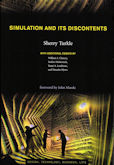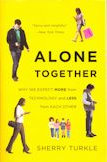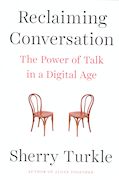Millions of people worldwide now interact via computers, often assuming personalities of their own creation.
But what is the psychological effect of such game playing?
Sherry Turkle examines the wonders and the dangers of virtual
interaction and the profound impact it has on our lives.
We are using ‘life on the screen’ to engage in new ways of thinking about
relationships, politics, sex and the self.
Based on nearly two decades of research,
observing the often intense and emotional relationships that people have through and with computers,
Life on the Screen is a fascinating and disturbing exploration of the new electronic age.
We are using
life on computer screens to become more comfortable with new ways of
thinking about evolution, relationships, sexuality, politics and
identity. How all of this is unfolding is the subject of this book.
Turkle explores a lot of fascinating territory in this book. She
looks at how, as the computer has grown more complex over the last two
decades, our reaction to it has grown less hostile. We still think of
it as ‘different’, ‘not-alive’, but no longer ‘mere machine’. She
looks at the history of Artificial Intelligence and Artificial Life,
and how our metaphors have changed from symbolic, top-down,
transparent, reductionist computation, to those of a connectionist,
bottom-up, opaque, surface, holistic approach. With these changes in
metaphor, we have become more willing to contemplate that a machine
might be ‘intelligent’, and that we ourselves might be somewhat
machine-like.
With a changed
image of what machines could be, the idea that the mind could be one
became far less problematic.
[Myself, I do not believe that the ‘post-modernist’, surface-only,
approach is intrinsically better than the modernist reductionist
approach. Rather, I think that each provides one possible way of
thinking about a system, and that we need to use both ways,
and more, to get a fuller understanding.]
And she explores some people‘s lives in simulated computer worlds,
MUDs and chat-rooms, and how this allows them to explore multiple
personae, allowing them a more decentralised view of the self. For
some people RL (real life) is just one more persona, no more important
than the rest.
Turkle is a social scientist and psychologist. She has gathered the
material for this book by means of interviews with a wide cross
section of users, and she uses these interviews to provide a wealth of
fascinating illustrative anecdotes to flesh out her main thesis.
Very thought provoking fare. Here are some of the thoughts it
provoked in me.
The changing meaning of ‘transparency’
As computers have become more complex they have become opaque – we
can’t understand them as machines, and experience them on their
surface level only. We now interact with them by means of simulations
– not just video games, but simulations of pieces of paper, grids of
figures, boxes of index cards, and filing cabinets.
In the 1970s and early 1980s, when people claimed CP/M and MS-DOS
were transparent, they meant there was nothing to prevent them
seeing what was going on all the way down to the bare machine. Now in
the 1990s, claiming transparency for MacOS and MS-Windows, they mean
there is nothing from the machine intruding to prevent them seeing and
interacting with just the application: they ‘think in MS-Word’, the
machine itself has become opaque. These two opposed usages
reflect different styles of users: those who want to understand and be
in ‘control’ at all levels, and those who want to use the
applications. Interestingly, some people prefer MS-Windows over MacOS,
because they feel it gives the ‘the best of both worlds’; they can sit
on the surface as a user when they want to, and they can drop down
into MS-DOS when they feel the need, or when the surface transparency
illusion can no longer hold.
I appreciate both styles. The order I was introduced to computers
was: IBM mainframe and Cray supercomputer (early 1980s), BBC micro
(mid 1980s), Sun Unix workstation (late 1980s), Macintosh (early
1990s) and MS-Windows (mid 1990s). As a user of applications
(spreadsheets, word processors), I prefer the windowing ‘surface’
interface of the newer machines, but as a developer I really do need
that extra level of control. And in my experience, MacOS gives the
best surface, but is a pain when something goes awry (“I just
want a command line so that I can tell it what to do” –
after all, we invented writing thousands of years ago because pictures
only communicate if you already know what they mean). Unix
gives the best depth, but is not at all easy for the novice or casual
user (“Unix is a great place to live, but I wouldn’t want to
visit there”). So, whenever I use MS-Windows, I can always think
of a different machine I would prefer to be using in that style (but,
of course, it’s not always the same different machine).
‘Top down’ versus ‘bricolage’ programming
In the 1980s, programming was taught as ‘structured’, and ‘top down
design’, and anyone who wanted to use a ‘bottom up’ or ‘bricolage’
approach was penalised. Turkle tells a story of the way she preferred
to write essays: lots of ideas on little bits of paper scattered
about, rearranged, gradually brought into a structure. So to satisfy
her teachers, who were of the ‘outline this week, essay next week’
school, she would write the entire essay in the first week, then
abstract an outline from it. With the advent of ‘surface’ computing,
encouraging an experimental, ‘try it and see’ approach, the bricolage
style has come to be a better way of interacting with computers.
I think the truth lies, and has always lain, half way between these
extremes of total rigidity and total fluidity. Some structure is
needed, but it is there as a guide, not an immutable framework, and
when the details being fleshed out don’t fit, or suggest a better
approach, or reveal something previously unknown, then the structure
is revised. Software design, or essay writing, is an iterative
process.
And this fits in with how programming is really done. Every
one knows the old ‘waterfall model’ (specification, then design, then
coding, then testing) is some abstraction that rarely if ever happens
in practice. Indeed, I remember being at a talk given by Edsgar
Dijkstra where he himself said that top down programming was a good
way to document a design, but he never meant it to be the way to do
the design in the first place. So maybe Turkle and her interviewees
suffered teachers who had fallen for the idea that the ‘post hoc
rationalisation’ was in fact the development process. And
maybe, in the 1990s, the message is getting through to those teachers.
Let’s just hope we don’t end up spending a decade at the other,
bricolage, extreme!




